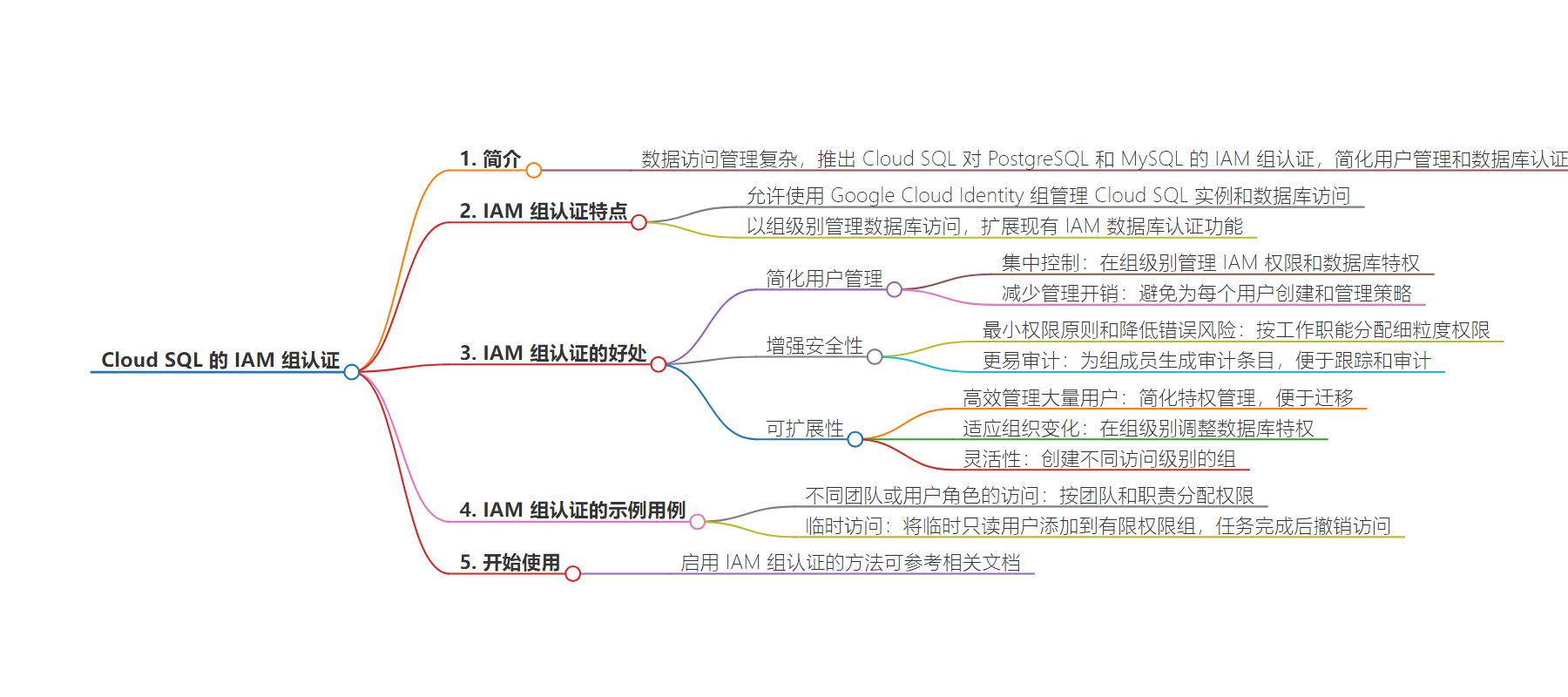包阅导读总结
1. 关键词:Cloud SQL、IAM 组认证、PostgreSQL、用户管理、数据库安全
2. 总结:Cloud SQL 推出 PostgreSQL 和 MySQL 的 IAM 组认证,简化用户管理和数据库认证。该认证具有集中控制、增强安全性、可扩展性等优势,适用于不同团队或用户角色的访问、临时访问等场景,启用方法可参考相关文档。
3. 主要内容:
– Cloud SQL 推出 IAM 组认证
– 用于 PostgreSQL 和 MySQL,简化管理和认证
– IAM 组认证的特点
– 允许使用 Google Cloud Identity 组管理访问
– 扩展现有 IAM 数据库认证功能
– IAM 组认证的好处
– 简化用户管理
– 集中控制
– 减少管理开销
– 增强安全性
– 遵循最小权限原则,降低错误风险
– 便于审计
– 具有可扩展性
– 高效管理大量用户
– 适应组织变化
– 具备灵活性
– IAM 组认证的示例用例
– 为不同团队或用户角色提供访问
– 提供临时访问
– 如何开始使用 IAM 组认证
– 可通过多种方式,参考文档学习启用方法
思维导图:
文章地址:https://cloud.google.com/blog/products/databases/announcing-iam-group-authentication-in-cloud-sql/
文章来源:cloud.google.com
作者:Shambhu Hegde,Neha Bhatnagar
发布时间:2024/7/29 0:00
语言:英文
总字数:709字
预计阅读时间:3分钟
评分:81分
标签:Cloud SQL,IAM 组身份验证,PostgreSQL,MySQL,Google Cloud
以下为原文内容
本内容来源于用户推荐转载,旨在分享知识与观点,如有侵权请联系删除 联系邮箱 media@ilingban.com
Managing and auditing data access can be very complex at scale, in particular, for a fleet of databases with a myriad of users. Today, we’re launching Identity and Access Management (IAM) group authentication in Cloud SQL for PostgreSQL and Cloud SQL for MySQL, simplifying user management and database authentication. Now, developers, database administrators, and security admins can benefit from simplified database access, better security controls, and more efficient user management at scale.
Cloud SQL IAM group authentication allows customers to use Google Cloud Identity groups to manage access to Cloud SQL instances and databases. IAM group authentication extends existing IAM database authentication functionality by allowing database access to be managed at the group level instead of the individual user level.
Benefits of IAM group authentication
IAM group authentication offers several benefits over individual user or service account based IAM authentication.
Simplified user management
-
Centralized control: You manage IAM permissions and database privileges at the group level, making it easier to add, remove, or modify access for multiple users simultaneously. This makes it easy to ensure consistent and uniform access, since all the users within the same group have the same IAM permissions and database privileges.
-
Reduced administrative overhead: With IAM group authentication, you avoid creating and managing database access policy for each individual user, saving time and effort. You can relieve database administrators and security admins from repetitive tasks when administering database access.
Enhanced security
-
Principle of least privilege and reduced risk of errors: Assign granular permissions to groups which represent job functions, adhering to the principle of least privilege and minimizing the risk of unauthorized access.
-
Easier auditing: Audit entries are generated for each group member if audit logging is enabled. This allows you to track and audit each group member’s access, which makes compliance and incident management simpler.
Scalability
-
Efficient management of a large number of users: IAM group authentication simplifies database privilege management even when you have hundreds of developers or users that need access to the database. Migration to Cloud SQL becomes easier since you can migrate database users using IAM groups.
-
Adaptability to organizational changes: Now it’s easy to adjust database privileges for entire groups in response to organizational changes, such as new teams or projects. When someone joins or leaves a team, you can manage such changes at the group level rather than at the individual user level, reducing the risk of stale or excess privileges.
-
Flexibility: You can create multiple groups with varying levels of access, enabling you to tailor database privileges to specific job functions and responsibilities.
Overall, IAM group authentication provides a more efficient, secure, and scalable approach to managing access control compared to individual user-based IAM authentication. It streamlines administrative tasks, reduces the risk of errors, and lets you easily adapt to changes in your organization’s structure and needs.
Example use cases of IAM group authentication
-
Access for different teams or user roles: Different teams need differing levels of database privileges. IAM group authentication’s group-based approach helps you assign privileges in a way that fits your organization’s teams and responsibilities. For example, you can create a developer group and testing group to limit access to development databases and test databases respectively, implementing the principle of separation of duties..
-
Temporary access: Users that require temporary read-only access can be added to a group with limited privileges to database objects. When the users have finished their task, their access can be revoked more easily.
Getting started with IAM group authentication
Enabling IAM group authentication for your environment is straightforward. To learn how to use IAM group authentication using the gcloud CLI, the cloud console, Terraform, or the API, refer to the documentation.
